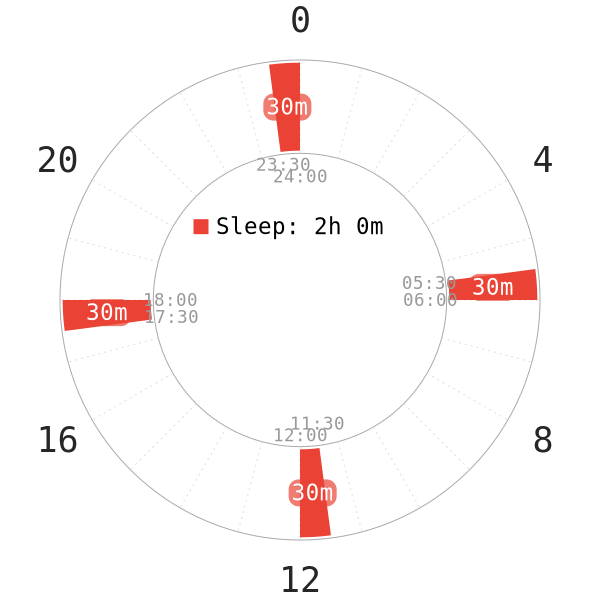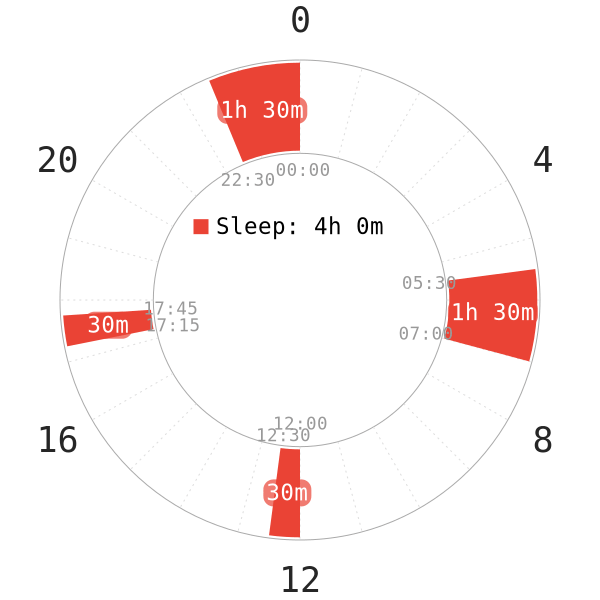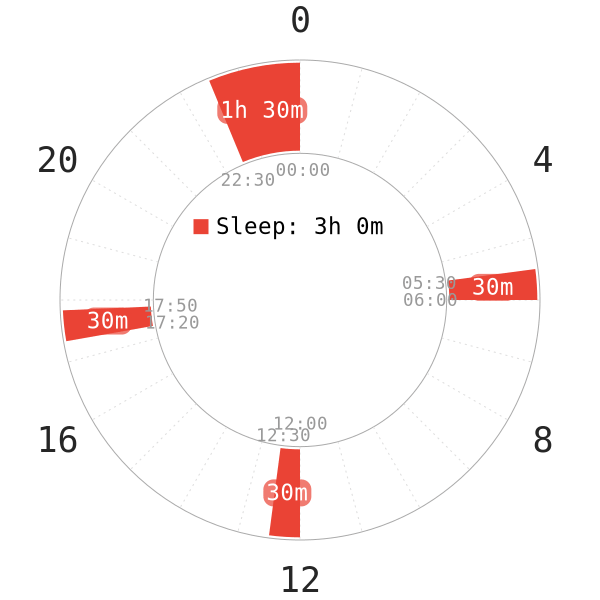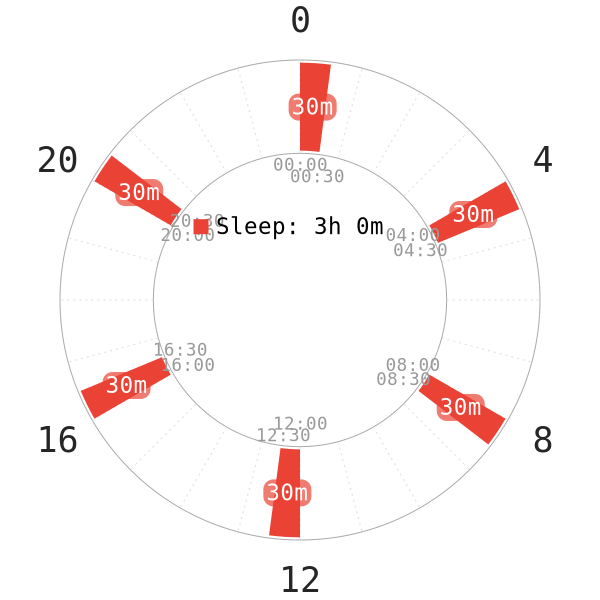
The Dymaxion sleep schedule is one of the most well-known polyphasic sleep schedules. It is made up of four equidistant 30m naps taken every 6 hours, totaling only 2h of sleep a day. There is also no core sleep. It is unlikely for a person with average sleep requirements to get all necessary sleep on this schedule, so chronic sleep deprivation is present unless you naturally require a low amount of sleep on a monophasic schedule.
The schedule was first proposed by Buckminster Fuller in the 1930s, who reportedly slept on this schedule for most of the time between 1932 and 1933. Dymaxion stands for “Dynamic Maximum Tension“; Fuller applied this phrase to many of his inventions, including a house, a car, and a map.
Content
- Dymaxion vs Uberman
- Adaptation
- Alternate Variants
- Lifestyle Considerations
Dymaxion vs Uberman
Most things that apply to Uberman also apply to Dymaxion. Because it is a nap-only schedule with a total of only 2h of sleep time, it has a lot of similarities to Uberman. However, Dymaxion still tends to be less popular than Uberman.
- This includes the extremely high difficulty, miniscule success rate, insane adaptation, and basically no flexibility.
- Like with Uberman, all of the SWS and REM must come from naps on this schedule.
- Thus, the amount of SWS and REM in proportion to light sleep is very high.
Difficulty-wise, Dymaxion is harder than Uberman. Because of the larger gap between naps (5h30m compared to 3h40m), the wakefulness-sustaining capacity of naps is going to falter. The nap duration during adaptation, however, is the hardest part of the schedule.
Dymaxion naps
- SWS will usually begin at around the 25-minute mark even when the SWS pressure is low.
- After the first day or two, every nap is going to end in SWS because the nap is long enough to cross this SWS boundary.
- In contrast, on Uberman, the 20m naps will contain SWS only after the SWS pressure hits a peak.
- Alternatively, it occurs when the sleep cycle compresses enough that SOSWS starts earlier. This means that nap-only schedules with 20m naps don’t get SWS wakes until some time has passed on the schedule.
- Even in the beginning of adaptation, the Dymaxion naps are harder to wake from than the Uberman naps. This is because they all have SWS wakes.
- SWS wakes result in a lot of grogginess after awakening (sleep inertia). Waking up from every nap is going to be difficult until the body gets used to the nap length and performs wake time programming.
- They also incur difficulty of hearing alarms,. This means that even those with high willpower are going to struggle to wake up.
- Finally, in SWS wakes, you are very prone to immediately falling back asleep unless you stand up.
- Naps that end in SWS also have the disadvantage of forgetting or not having dreams when you wake up.
The benefit from doing this schedule over Uberman is the larger wake period between naps. This can be useful for activities and other life commitments.
Adaptation
Dymaxion has very similar rules as Uberman, and adaptation is likely going to be impossible without human supervision.
Scheduling Variations
Bimaxion (4 hrs) and Trimaxion (3 hrs)


These transitional gradual adaptation schedules follow the same concept as the Uberman transitional ones like E5.
- The end results are Dymaxion-style schedules where cores become naps.
- Starting from Bimaxion, one core becomes a 30m nap after a successful adaptation. The process continues until every sleep block is 30m long.
- However, this approach suffers from the same issues as the gradual adaptation to Uberman.
Dymaxion-6 (D6)

- Sleep Duration: 3 hours
- Adaptation difficulty: EXTREME
Dymaxion-6 it resembles the structure of Uberman a lot. The only difference is the 30m naps instead of 20m naps. What practically makes a difference is that the naps on Dymaxion-6 have much worse wakes than the naps on Uberman during adaptation, due to their duration.
- At most, only a handful of people have been able to adapt to this variation.
- It also suffers from the same problems as Uberman, namely the inconvenient scheduling.
- It also has the same problems as other nap-only schedules, such as extreme rigidity and questionable health impacts. Therefore, this schedule is not the best choice for long-term practice.
This schedule is EXTREMELY DIFFICULT while still having 3h of total sleep time due to the problematic SWS wakes mentioned above.
Research
Interested in a research paper of Dymaxion sleep? Read here.
Lifestyle Considerations
Utilities
- Compared to Uberman, Dymaxion can have an edge in scheduling longer activities thanks to the longer wake gap between each nap.
- The 2 daytime naps can fit into regular jobs if there is a permissible nap window (e.g, noon break, or lunch break). The other nap can be after work hours.
- Unlike its easier “-maxion” counterparts, Dymaxion’s nap around midnight does not suffer as much from the hindrance of social activity. The nap is much shorter and can start at midnight.
- For a nap-only schedule, Dymaxion has a solid standing for practicality of usage. For this reason, it is sometimes preferable to Uberman.
Other Important Notes
- It is so far impossible to move any naps on Dymaxion even after the adaptation phase is complete.
- Regular alarms remain mandatory, because of the very low total sleep.
- However, one successful case has shown that some form of moderate exercises (e.g, light lifting or calisthenics) are possible on Dymaxion. While this is an impressive feat, said Dymaxion sleeper also admitted frequent muscle soreness and a noticeably slowed recovery rate after each exercise session.
- Same as other nap-only schedules, there can be long-term health risks of Dymaxion (e.g, glymphatic system). Thus, average sleepers should not attempt Dymaxion.
Main author: Crimson & GeneralNguyen
Page last updated: 8 April 2021
